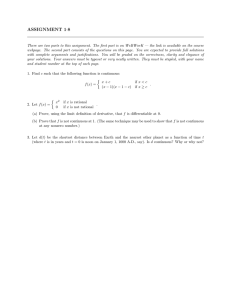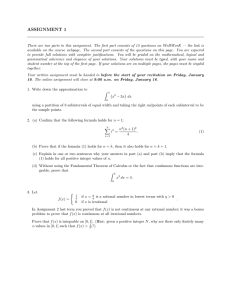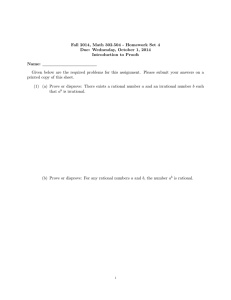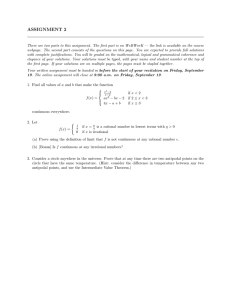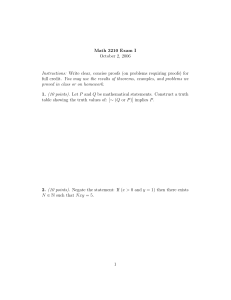Projects 1: on various types of numbers Instructions Renzo’s math 281
advertisement
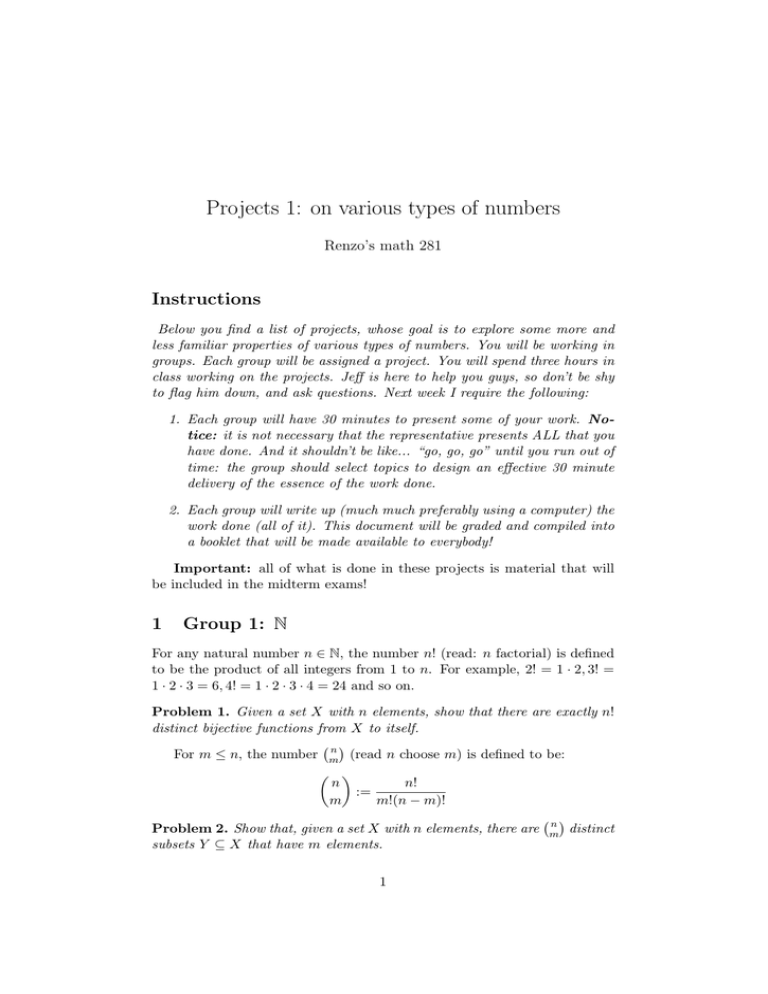
Projects 1: on various types of numbers
Renzo’s math 281
Instructions
Below you find a list of projects, whose goal is to explore some more and
less familiar properties of various types of numbers. You will be working in
groups. Each group will be assigned a project. You will spend three hours in
class working on the projects. Jeff is here to help you guys, so don’t be shy
to flag him down, and ask questions. Next week I require the following:
1. Each group will have 30 minutes to present some of your work. Notice: it is not necessary that the representative presents ALL that you
have done. And it shouldn’t be like... “go, go, go” until you run out of
time: the group should select topics to design an effective 30 minute
delivery of the essence of the work done.
2. Each group will write up (much much preferably using a computer) the
work done (all of it). This document will be graded and compiled into
a booklet that will be made available to everybody!
Important: all of what is done in these projects is material that will
be included in the midterm exams!
1
Group 1: N
For any natural number n ∈ N, the number n! (read: n factorial) is defined
to be the product of all integers from 1 to n. For example, 2! = 1 · 2, 3! =
1 · 2 · 3 = 6, 4! = 1 · 2 · 3 · 4 = 24 and so on.
Problem 1. Given a set X with n elements, show that there are exactly n!
distinct bijective functions from X to itself.
n
For m ≤ n, the number m
(read n choose m) is defined to be:
n
n!
:=
m
m!(n − m)!
n
Problem 2. Show that, given a set X with n elements, there are m
distinct
subsets Y ⊆ X that have m elements.
1
Problem 3. Prove that
n+1
n
n
=
+
.
k
k
k−1
Try to see if you can come up with two different proofs.
Problem 4 (The handshake problem). Given a group of n persons, if everybody shakes hands with everybody else, how many handshakes have been
exchanged in total?
Problem 5. Find a formula for the sum of the first n integers:
1 + 2 + . . . + (n − 1) + n =?
Try to prove this formula in five different ways. (Yes, you can ask Jeff for
help!!)
Problem 6. Find a formula for the sum of the first n squares:
12 + 22 + . . . + (n − 1)2 + n2 =?
Problem 7 (challenge). Prove that the formula for the sum of the first n
k-powers is a polynomial in n of degree k + 1.
1k + 2k + . . . + (n − 1)k + nk = ak+1 nk+1 + . . . + a0
Note: I am not asking you to find the formula for such a polynomial!!
2
Group 2: Q
A number q ∈ Q if it can be expressed as a ratio of two integers:
r=
m
n
Of course such an expression is not unique, since r = 2m/2n = 37m/37n =
. . . etc.
Problem 1. Prove that the set of rational numbers Q is countable.
Problem 2. Prove that between any two rational numbers there is always
one (and therefore infinitely many) rational number.
Problem 3. Prove that:
1. if you add two rational numbers you get a rational number;
2. if you multiply two rational numbers you get a rational number;
2
3. for any non-zero rational number, it has a multiplicative inverse.
Problem 4 (geometric series). Given a number q 6= 1 ∈ Q (in reality here
the number could very well be a real number instead, but it is not important...), prove that
N
X
1 − q N +1
qi =
1−q
i=0
Deduce that if |q| < 1
lim
N →+∞
N
X
qi =
i=0
1
1−q
We are familiar with the fact that a rational number (and in fact any
real number as well) has a decimal expansion; for rational numbers, it can
for example be obtained by doing long division. A decimal expansion is said
periodical if eventually there is a cluster of digits that repeat themselves
over and over for ever. For example:
1
= 0.333333333333 . . .
3
1
= 0.0227272727272727 . . .
44
Problem 5. Use the previous problem to prove that
0.999999 . . . = 1
Problem 6 (challenge). Prove that a number q is rational if and only if
its decimal expansion is periodical. Devise a procedure to recover a fraction
given a periodical number.
3
Group 3: R
Here we are not going to rigorously define real numbers (which is quite a
task), but rather work with the intuitive notion you already have. As a set,
R is in bijection with the points of a line. Real numbers can be expressed
as (limits) of possibly infinite decimal expansions.
Problem 1. Prove that R is an uncountable set.
Hint: try to prove this by contradiction. Assume R countable, and
put all real number in a list. Write them out in a list with their decimal
expansion. Now create the decimal expansion of a number which is NOT in
that list.
3
Problem 2. Construct a bijection between R and the open interval (−1, 1).
Try to do it in two conceptually different ways.
√
Problem 3. Prove that 2 is not rational.
√
Problem 4. Prove that n is rational if and only if it is an integer.
A real number which is not rational is called irrational.
Problem 5. For each of the following statements, either prove it is true or
give a counterexample to show it is false:
1. The product of two irrational numbers is always irrational.
2. The product of two irrational numbers is always rational.
3. The product of a non-zero rational and an irrational is always irrational.
For a subset A ⊂ R, the supremum of A (typically denoted sup(A)) is
a number ā such that:
1. ā is greater or equal than any element of A.
2. for any > 0, you can find an element a ∈ A such that
0 < ā − a < If there is no number larger than any element of A, then we say that
sup(A) = ∞.
It is a hard fact, that we will give for granted, that for any subset A of
R, sup(A) always exists(as a number or as ∞).
Problem 6. Prove that for any A ⊆ R, sup(A) is unique.
Problem 7 (challenge). Prove that any positive real number r has an n-th
root (for n any positive integer). This means there exists a real number r0
such that
(r0 )n = r
4
Group 4: Z/nZ
Consider the following equivalence relation on the set of integers Z: a ∼ b if
b − a is divisible by n. We denote the quotient set by Z/nZ.
Problem 1. Check that this indeed is an equivalence relation. How many
elements does the quotient set have?
Consider the following two functions:
4
1.
multn : Z → Z
x 7→ n · x
2.
π : Z → Z/nZ
y 7→ [y]
the natural quotient function.
Problem 2. Show that:
1. multn is injective;
2. π is surjective;
3. the range of multn is precisely the subset of elements z ∈ Z such that
π(z) = [0].
Problem 3. Define the operations of addition and multiplication on Z/nZ.
Worry for a second: are such operations well defined? (i.e. if you define on
a representative of an equivalence class, make sure that the result is independent of the choice of the representative). What are the identity elements
for these operations?
Problem 4. Let us call 0 the identity element for addition that you defined
in the previous problem. Decide whether the following proposition is true or
false:
I: If a, b ∈ Z/nZ are such that a · b = 0, then either a = 0 or b = 0.
Let us call 1 the identity element for multiplication. Decide whether the
following statement is true or false:
II: If 0 6= a ∈ Z/nZ, a has a multiplicative inverse, i.e. there exists an
element b ∈ Z/nZ such that a · b = 1.
If you decided that some of the statements above are not true in general,
what are the values of n ∈ N that make the statements true? Also, are the
two statements related to each other?
Problem 5. Thirty salamanders live on a desert island: 15 are red, 7 are
blue and 8 green. When two of a different color meet, they both change into
the third color. When two of the same color meet, one changes into each
of the other colors (e.g. if two reds meet, one becomes green and the other
blue).
Can it ever happen that at some point in the future, all of the salamanders are of the same color?
Hint: think of Z/3Z...
5
Problem 6. Prove the following two divisibility criteria:
divisibility by 3: an integer n is divisible by 3 if and only if the sum of
its digits is. For example:
1349870(→ 1 + 3 + 4 + 9 + 8 + 7 + 0 = 32)
is not divisible by 3.
divisibility by 11: an integer n is divisible by 11 if and only if the alternating sum of its digits is. For example:
1140876(→ 1 − 1 + 4 − 0 + 8 − 7 + 6 = 11)
is divisible by 11.
Problem 7 (challenge). Consider the cartesian product X = Z/3Z × Z/5Z.
Endow X of addition and multiplication by doing it coordinatewise:
([a1 ], [b1 ]) + ([a2 ], [b2 ]) = ([a1 + a2 ], [b1 + b2 ])
([a1 ], [b1 ]) · ([a2 ], [b2 ]) = ([a1 · a2 ], [b1 · b2 ])
Check that these operations make sense. Let Y = Z/15Z. Construct a
bijective function:
F :X→Y
that preserves the operations. I.e., for any x ∈ X, y ∈ Y :
F (x + y) = F (x) + F (y)
F (x · y) = F (x) · F (y)
Would this work if instead of 3, 5, 15 we had picked 3, 6, 18? What conditions must you put on two numbers m, n in order to have an operation
preserving bijection:
F : Z/mZ × Z/nZ → Z/(m · n)Z?
Historical note: what you just showed (albeit in more modern language) is an ancient theorem called the Chinese Remainder Theorem.
6
5
Group 5: C
Define C to be the set of numbers of the form z = x + iy, where:
• x and y are real numbers.
• i is a “new number” (if you want you can think of it as just a symbol),
with the property that i2 = −1. It is now clear that i is not a real
number, because the square of any real number is always non-negative.
Addition on C is defined in the “natural” way:
(x1 + iy1 ) + (x2 + iy1 ) = (x1 + x2 ) + i(y1 + y2 )
Multiplication is defined by treating two complex numbers as polynomials in i and then substituing −1 every time you get an i2 :
(x1 + iy1 ) · (x2 + iy1 ) = (x1 · x2 − y1 · y2 ) + i(x1 · y2 + x2 · y1 )
Problem 1. Prove that for any non-zero complex number, it has a unique
multiplicative inverse.
Problem 2. Define a natural bijection between C and the plane R2 . Show
that the sum of complex numbers “behaves well” with respect to this bijection.
It is however less clear how to interpret multiplication.
Consider the half line ` = {z = x + iy ∈ C s.t. y = 0 and x ≥ 0}. Any
point z in the plane can be described, besides by its x and y coordinates,
also by the following two numbers:
• ρ (a positive real number): the distance between z and the origin.
• θ (an arbitrary real number): the angle, expressed in radians, between
the half line ` and the half line from the origin through z.
Problem 3. Let X = R≥0 × R be the set of all possible pairs (ρ, θ). Define
an equivalence relation ∼ on X so as to obtain a natural bijection F : C →
X/ ∼. Describe explicit formulas for F and its inverse.
Problem 4 (de Moivre’s theorem). Let z1 , z2 be two complex numbers, and
F (z1 ) = [(ρ1 , θ1 )],
F (z2 ) = [(ρ2 , θ2 )].
Prove that:
F (z1 · z2 ) = [(ρ1 · ρ2 , θ1 + θ2 )]
Problem 5. Use the previous problem to give a geometric description of
the inverse of a non-zero complex number.
7
Problem 6. Using de Moivre’s theorem, show that 1 has precisely n n-th
roots. I.e. there are n distinct complex numbers zi (i = 1, . . . , n) such that:
zin = 1
Describe how these n numbers position themselves in the plane. What can
you say about the n-th roots of an arbitrary complex number z?
Given a complex number z = x + iy, its conjugate is defined to be
z̄ = x − iy.
Problem 7 (challenge). What is the product z · z̄? Prove that the product
of two complex numbers z1 , z2 is a real number if and only if
z2 = rz¯1
for some positive real number r. Use this result to prove the following theorem.
Theorem. The roots of a quadratic equation with real coefficients are either two (possibly coinciding) real numbers or a pair of conjugate complex
numbers.
8
